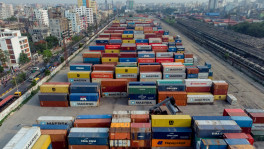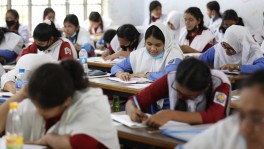Revisiting juvenile delinquency from a sociological lens
If juveniles receive affection and achieve a sense of unity from family, school, sports, cultural activities, volunteering etc, they are less likely to seek unethical means

In recent times, Bangladesh has seen a rise in teen-gang culture and violence stemming from juvenile delinquency.
From shoplifting and mugging, grave vandalism, cyberbullying, ragging, intoxication, drug peddling, assaults, murders, and stalking to rape – these sporadic activities of juvenile delinquents can no longer be identified as mere nuisance.
These are felonies that should be punishable by the law. Juvenile delinquency being a sensitive topic comes with its own set of complications, which is multiplied further as the number of children aged 5-18 years is about 40 million in the country.
The term 'juvenile' is a derivative of the word 'juvenis', meaning young. A young person who is not fully grown and old enough to be considered an adult is a juvenile.
As per the UN second congress, juvenile delinquency may be referred to as the activities by children which are inconsistent, not recognised by the society and are a violation of law.
Classical criminology says that juvenile delinquency like any other form of crime resides within individuals.
Again, as per positivist approaches, modification in delinquency is detected with alteration in time and territories, and is related to the non-existence of communal institutions like family, school, places of worship etc.
The labelling theory affirms that, once individuals, especially if they are young, are branded as criminals, they are more likely to commit crimes.
According to social scientists Lening Zhang and Jianhong Liu, the four risk factors of juvenile delinquency are - individual's personality, complications in family, deterioration of mental health, and substance abuse.
Studies suggest that parental negligence and familial turmoil are likely to trigger juvenile delinquency.

Differential Association theory ratifies that, delinquents fulfill criminal objectives via social ties. Hence, juvenile delinquents are united in gangs upon racial, ethnic, economic, even religious common grounds.
They are served with nicknames and mottos. They develop code languages and hand signs. Changes are detected in dressing and hairstyles.
All these give juveniles a sense of belonging and solidarity. They feel secure and their problems are taken care of in immoral ways.
When three or more individuals function as a group to create an environment of intimidation, it is known as a gang. The main function of gangs is to create violence and take part in criminal activities.
Gang members strive to uphold supremacy and acquire economic resources. Rivalry among gangs is common which escalates restlessness.
Gangs usually fall into three categories: Peer groups, street gangs, and organised crime groups. All of these are harmful for the members, their kith and kin and the society.
Juveniles form and join gangs for various reasons including shelter, enjoyment, esteem, financial support and peer pressure.
As reflected in the Rational Choice theory, crime being profitable, delinquents commit it for self-interest.
The causes of juvenile delinquency in Bangladesh include:
Political and socio-cultural transition and migration
The transition from agriculture to industrialisation and rapid urbanisation bring changes in livelihood. The clashes between traditional and modern values cause juvenile delinquency.
On the other hand, the political stability ranking of Bangladesh is 172 with an index of -1.15, denoting irrefutable political tremors.
This is endorsed by Anomie theory, which professes that political instability and cultural transmission leads to normlessness which, in turn, provokes crime.
As per the Strain theory, straining is initiated due to friction between objectives and means, generating discontent. Migration from urban to rural areas and vice-versa may cause juvenile delinquency.
Poverty and lack of education
It is often the root cause of juvenile delinquency as they are deprived of basic needs and unable to access traditional or vocational education. Without education, it is increasingly difficult to recognise one's duties or to strive for development.
Family turbulence and criminality
Abusive parents, relatives or guardians lead to juvenile delinquency. Divorces, deaths and bad blood between family members should not disturb discipline and supervision of children.
Children are more likely to be delinquents if their family members are involved in criminal activities.
Influence of mass media and imitation
Glorification of crimes and violence incite juvenile delinquency. Children are likely to follow the footsteps of offenders when in close unsupervised contact.
In this post-modern society, communities form through information and communication technologies.
The toxic influence of mass media is reflected by teens on Facebook, Instagram, Tik-Tok, Youtube and other platforms.
Lack of healthy recreation
If young minds are not offered constructive recreation, they get involved in destructive activities.
Hazards and disasters
High temperatures and heavy rainfall are common in Bangladesh. Addition of Covid-19 has overwhelmed the already hazardous settings of the country and further catalysed other risk factors.
Domestic agitation should not be allowed to negatively affect the child. Education and mindful entertainment are to be provided along with the fulfilment of basic needs.
Community level supervision, training of teachers, guardians and health professionals, and softening academic 'zero tolerance' policies to reduce suspensions and expulsions are needed.
Special care of children with difficulty, promoting skills of interpersonal conflict resolution, raising awareness, and creating youth recreation centres will be helpful in eradication of juvenile delinquency.
There should be enough day-care centres to accommodate younger children. Practice of moral and religious education is also important.
There is a culture of impunity in juvenile delinquency in Bangladesh. Like matured criminals, juvenile delinquents take advantage of it.
However, their trial is conducted in conformity with the Children Act, 1974, Criminal Procedure Code 1898, Probation and Offenders Ordinance 1960 and Prison Code.
Teen-gang violence has become too fierce to be resolved by ordinary measures. If juveniles receive affection and achieve a sense of unity from family, school, sports, cultural activities, volunteering etc, they are less likely to seek unethical means.
Juveniles often fall into the wrong company and develop bad habits due to lack of attention and communication. Curiosity and energy of juveniles should be channeled into a positive direction.
To that end, their education and health (both mental and physical) are of paramount importance. Conscience, morality, ethics, discipline, and manners should be infused as early as possible. Efforts are to be made so that the teaching sustains in them throughout their lifetime.
But, the well-being of the youths is not entirely dependent on others like parents, teachers and society, but also on themselves. They should be steadfast about being honest and strive for legit means of achievement.
For this, systems of reward and punishment are helpful. The degree of both rewards and punishment should be within limit. This is because uncontrolled degrees result in juvenile twistedness and rebellion.
It is undeniable that special considerations are to be made due to the age of the offender, but the seriousness of the crimes cannot be overlooked.
For this reason, correctional institutions are set up. It is better to be on the right path from the very beginning than to be put into a correctional facility.
Al Jamal Mustafa Shindaini is Assistant Professor, Bangladesh University of Professionals (BUP), Mirpur Cantonment, Dhaka-1216. email: [email protected]d.
Raiyan Rahman is a graduate in Development Studies, Bangladesh University of Professionals (BUP), Mirpur Cantonment, Dhaka-1216. email: [email protected].
Disclaimer: The views and opinions expressed in this article are those of the authors and do not necessarily reflect the opinions and views of The Business Standard.


 Keep updated, follow The Business Standard's Google news channel
Keep updated, follow The Business Standard's Google news channel
















